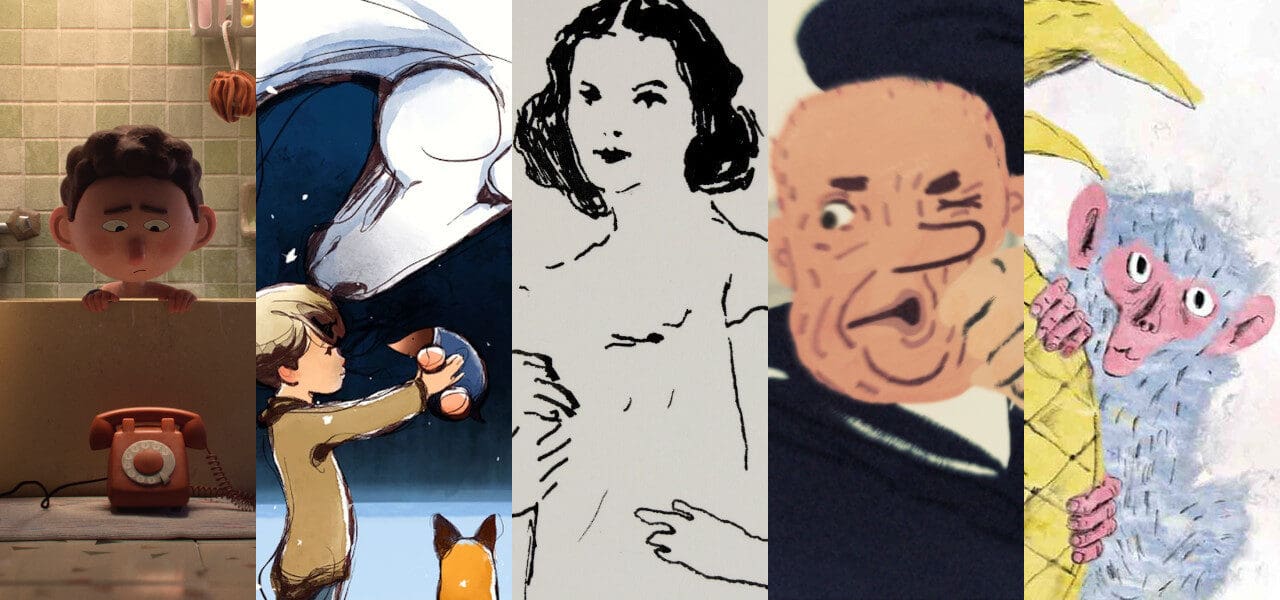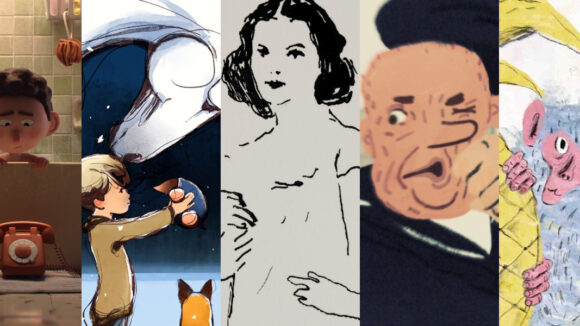

The Oscar Shortlist Interviews: What Inspired The 15 Stories
Fifteen animated shorts have been shortlisted for an Oscar this year.
To better understand how these films were crafted, we sent a series of questions to all the directors, to learn more about how they made their films. We are publishing their answers across three stories this week. This is the first of the three.
Our first question:
What was it about this story or concept that connected with you and compelled you to direct the film?
Uri Lotan (Black Slide)
The film was inspired by a chapter in my own young life. At the age of 12, coming back from a day at my local waterpark, my mother passed away after a yearlong battle with cancer. I’ve always been puzzled by the foreboding intuitive feeling that haunted me that day, and by how over the years the painful memory of my mother has become intercut and mingled with the playful, sunny day in the waterpark.
Peter Baynton, Charlie Mackesy(The Boy, the Mole, the Fox and the Horse)
Charlie Mackesy
A while ago I wrote a book about a boy, a mole, a fox and a horse – their conversations together journeying through the wild countryside. We decided to make a film, inspired by the book… I’d never made one before. The process has been an adventure I’d never imagined I’d have. It was important to be a part of it, and I am very lucky that the wonderfully gifted people I worked with helped me and we helped each other.
Peter Baynton
Initially, it was the beauty of Charlie Mackesy’s drawings that connected with me; their flowing and lyrical mark-making, and how simply (deceptively so) they capture a pose, an emotion, a moment, a connection. It felt like an irresistible, though rather daunting, challenge to figure out how they might become animated. Of course, the drawings are inseparable from the words and their meaning, so the idea that we could try to make a film that carried those same comforting, positive, important messages was very compelling. I was also excited by the prospect of making a quiet, simple film set in the English countryside landscape.
Elizabeth Hobbs (The Debutante)
The film is based on a short story called The Debutante which was written by the surrealist artist Leonora Carrington in the late 1930s. It’s loosely inspired by her own experience of rejecting the life that was planned for her by her parents. When I first read the story of The Debutante I found it so startling, funny, and courageous. We were lucky to get permission from the estate of Leonora Carrington to adapt the story for animation. The themes in the story particularly resonated with me and I love the tension in the situation of a hyena trying to behave while at a grand dinner party.
Wendy Tilby, Amanda Forbis (The Flying Sailor)
We were inspired by the true tale of a sailor who, in the catastrophic Halifax Explosion of 1917, was blasted skyward for two kilometers before landing unharmed and wearing only one rubber boot. We loved the idea of a pink, naked sailor flailing balletically as he rises above the smoke and mayhem, and we thought there was beauty—and humor—in his terrible predicament. Our concept was to expand what would have been a few seconds in the air into as many minutes and imagine the sailor’s flight in slow motion as a visceral and transcendent near-death experience.
Laura Gonçalves (The Garbage Man)
I wanted to share a very personal story, the life story of my uncle Botão, told in different memories by my family, during a lunch gathering in Belmonte. After living in a dictatorship and coming back from war, he emigrated to France illegally where he worked as a garbage man, collecting objects others threw away and fixing them to take back to Belmonte to share like treasures with family and friends. His story is representative of thousands of Portuguese that went through the same experiences. So, starting from a personal and family vision to a socio-political context of that time, my uncle’s story is also the same lived by those who lived through the harshness and oppression of the Salazar dictatorship, the Colonial War, and the great wave of clandestine emigration of the 1960s.
João Gonzalez (Ice Merchants)
I’m interested in creating realities and scenarios that are inspired by images that come from my subconscious and using them as metaphors to talk about topics that are dear to me and that touch me on a personal level. This makes the films personal to me both on the subconscious and conscious level, helping me immerse deeply into them while I’m creating. The fact that my films always take place in surrealistic and impossible realities (possible only in the realm of animation) helps me to expose myself more and to be more open about the topics I cover because although they are inspired by personal themes, they are never strictly about myself and could never be. Making films like this helps me understand myself better and, therapeutically, to be more at peace with topics that concern me; in this case, loss.
Robert-Jonathan Koeyers (It’s Nice in Here)
In 2016, I came across a harrowing video of a woman live-streaming her boyfriend bleeding to death in the driver’s seat next to her. Her pleas and prayers were occasionally interrupted by the police officer yelling at himself in the background with a genuine sense of panic in his voice. Over the following few months, I kept tuning in to see how this story was unfolding, how new narratives were being formed, and how polarizing and often reductive the conversations surrounding this, as well as many other horrific police shootings, would become. This formed the foundation of It’s Nice in Here, in which we try to explore how the world looks at Black bodies, how stories about victims of police violence are told, and how they will eventually be remembered. I’ve had moments in my life where I looked at my previous body of work and realized, like so many other Black and POC animators have, that I didn’t see myself represented in the characters I drew or in the stories I was telling. During the last few years of working on this film, it has felt so incredibly healing and important to center the lived experiences of people that look like me in my work more.
Amy Bench (More than I Want to Remember)
Stories of migration have always been important to me, but I’ve become more devoted to the cause over the last few years, especially as immigration has become so talked about and so depersonalized and deeply politicized. Several years ago, I began reaching out to refugee assistance programs in my community and across the country to meet women who were interested in sharing their journeys. Mugeni was someone I met in 2019 and I was drawn to her as soon as we connected. She has an infectious energy and her story was so urgent and underreported, with few outside of the region knowing about the persecution of the Banyamulenge people. Mugeni’s story has so many profound moments and lessons that resonate so strongly beyond her own experiences. Her language is very visual and visceral. One of my favorite lines of hers is, “My heart was speechless, my tears were stuck inside of me…” Hearing the poetry in her voice during our interviews was really affecting—her words communicate so much about her experience and, most importantly, her state of mind, in those moments.
Sara Gunnarsdóttir (director) Pamela Ribon (writer) (My Year of Dicks)
Sara Gunnarsdóttir:
Pam’s writing is beautiful and personal and universal and wonderfully feminine. I was thrilled that she wanted to work with me and honored that she trusted me with her vulnerable adolescence.
Pamela Ribon:
Having worked in the incredibly large and corporate culture of big-studio animated films, I wanted to find a more independent route to help lead an animation pipeline for a story that was more personal. Megan Reid and John Agbaje (then both at FX) suggested adapting my memoir using animation to let my teenage fantasies not just illustrate flights of fancy, but immerse the viewer in genre. This was a unique way to show how much we can bend to make a pretty shitty situation seem “perfect,” while enjoying the “too-muchness” of trying on a new persona.
Jérémie Balais, Jeff Le Bars, Raúl Domingo, Colman Domingo (New Moon)
The theme of the love between mother and child always inspired us. In animation, you can explore that love through the magic of the imagination, the dream, and the poetry. Colman and Raúl wrote this beautiful story, and we felt that the wizardry of animation would truly burst it open. With New Moon we felt incredibly free, especially with one of us- Jérémie- expecting his first child at the time. The anticipation of parenthood and its beauty were at the heart of his thoughts at the time of working on New Moon. Depicting transformation, the magic of newness, and the impact of the new life was incredibly inspiring.
Lachlan Pendragon (An Ostrich Told Me the World Is Fake and I Think I Believe It)
When stop-motion animating, I spend a lot of time playing with puppets and making them walk around miniature sets. I think it’s only natural to consider what would happen if they became aware of their constructedness. I felt a story like this would provide me the perfect opportunity to explore the appeal of stop motion and make it unapologetically tactile, imperfect, and handmade.
Juan Pablo Zaramella (Passenger)
The short is about the limits between individuals and society, and how we need to process social codes, which are in constant movement. If we don’t interpret them, we could derail. The beginning of the project happened in the most literal way of my entire filmography: taking notes while traveling alone on a train, as the main character.
Spencer Susser (Save Ralph)
I’ve been vegan for about nine years and have always wanted to do something to help animals in a meaningful way. Especially helping people connect the dots between cruelty toward animals and food we eat and the products we use. I was learning about the cruelty of cosmetic testing on animals and how prevalent it still is in the world so I wanted to do something to help call attention to it and hopefully create a real impact for animals.
Sander Joon (Sierra)
Sierra is inspired by my anxiety about living up to my parents’ expectations, and by their confusion about making the right parenting choices. It’s a universally understandable dilemma – how far should one go to force their dreams on their descendants? I’m happy to see how many people have recognized this feeling. The symbol of a boy becoming a car tire was so fascinating to me that it quickly drove me to build this whole absurd yet warm universe around it.
Špela Čadež (Steakhouse)
The subject of psychological violence has interested me particularly because I feel that as a society, we do not know how to talk about it. I see far too many relationships around me that are drowning in it. The story for the script was written by my partner Gregor Zorc and I remember the moment he told it to me; I knew immediately that this was the story I wanted to tell.
Answers were edited for length and clarity.

.png)